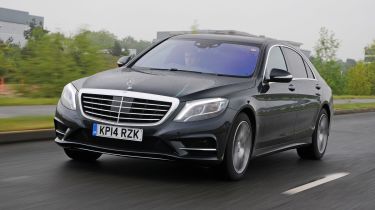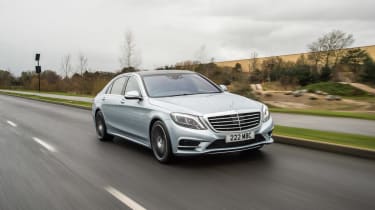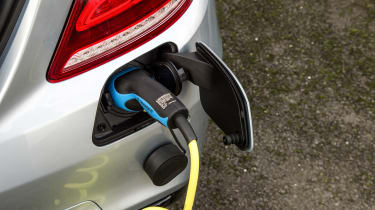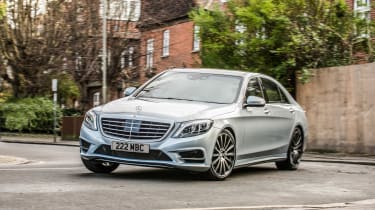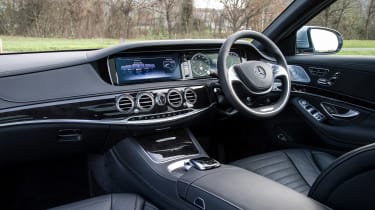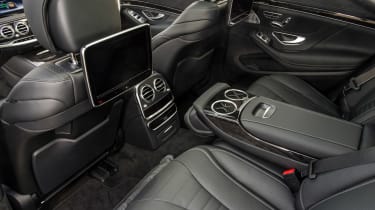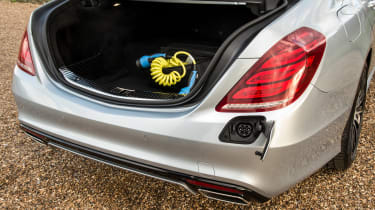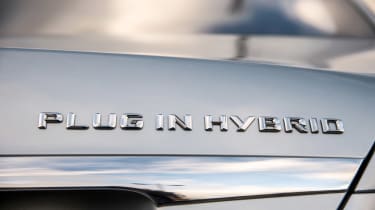Mercedes S-Class hybrid (2013-2018)
“One of the most luxurious, advanced and expensive hybrids available”
Pros
- Incredibly luxurious
- Strong performance
- Decent economy
Cons
- Very expensive
- Costly options
- Economy figures unrealistic
The hybrid versions of the Mercedes S-Class – the S300h and S500e – square up against cars like the Audi A8 and hybrid versions of the Porsche Panamera and BMW 7 Series. Both hybrid S-Class are the ultimate in luxury, combining market-leading technology with sublime ride quality, effortless performance and the kind of passenger comfort that’s hard to find anywhere else.
The S300h is the entry point to the S-Class range, with a starting price that puts it in line with other large executive cars like the BMW 7 Series and Audi A8. It’s a non-plug-in hybrid that combines a 201bhp 2.1-litre four-cylinder diesel engine with a 27bhp electric motor to produce a total of 228bhp. The S500e, meanwhile, is a plug-in petrol-electric hybrid that pairs a 328bhp 2.9-litre six-cylinder engine with a 114bhp electric motor for a total of 442bhp. Both are swift, but the latter is particularly fast for a car of this type.
If you simply must have the ultimate in luxury and performance from your hybrid, then the alternative-fuel Mercedes S-Class is a great prospect. You’ll need deep pockets, though; even an entry-level S300h with no options boxes ticked costs just shy of £76,000, while the mid-range S500e costs a shade over £91,500 in its ‘basic’ form. Whichever model you choose will be one of the most expensive hybrid options among its respective rivals – but probably the best, too.
MPG, running costs & CO2
As with all hybrids, one of the biggest attractions of these electrified S-Class are their impressive fuel economy and CO2 emissions figures. Mercedes claims the S300h returns 61.4mpg and emits 120g/km of CO2 – quite respectable figures for a car of this type. The S500e makes use of its plug-in hybrid technology to return even more impressive numbers: over 100mpg and just 65g/km of CO2. It’s important to remember, however, that it’ll be quite hard to reproduce this in everyday driving. If driven carefully, the S500e should impress with its economy, but once you start using the great performance on offer from the electric motor and petrol engine together, MPG figures will drop massively. Usefully, the S500e has an all-electric range of 18 miles – perfect for small trips around town. The S500e is also London Congestion Charge exempt.
Both cars qualify as ‘alternative-fuel vehicles’ under current road-tax rules, so after the first year’s CO2-weighted payment (£150 for the S300h, £15 for the S500e), you’ll pay £130 a year. But both cars have list prices well over £40,000 and therefore each is liable for a £310 yearly surcharge, payable in years two to six of ownership on top of the base rate of £130. In other words, your total bill in both cases during that time will be £440 a year.
More reviews
The hybrid S-Class come with Mercedes’ three-year/unlimited-mileage warranty. Mercedes care plans can be tailored to suit your annual mileage and can be paid for up-front or in monthly installments. Depending on your yearly mileage, these can start at around £41 a month for three services over three years, climbing to as much as £123 a month if you cover higher mileages and need three services a year.
Engines, drive & performance
Effortless, unruffled progress is the order of the day with the S500e. Its 442bhp means acceleration is impressive for a car of this sort, with 0-62mph covered in 5.2 seconds. The excellent seven-speed automatic gearbox deals well with the power on offer and there’s plenty of it low down to make overtaking and high-speed cruising a breeze. The diesel hybrid S300e is no slouch though, with 0-62mph taking 7.6 seconds and plenty of low-down power for safe overtaking. It’s the cheapest of the two, has more than enough power for most buyers and you’ll probably find it easier to get close to the claimed MPG figures than with the S500e – especially if long motorway journeys are your bread and butter.
All Mercedes S-Class are effortless to drive – good news for chauffeurs and owner-drivers alike. Both hybrid models are good to drive, with both having air suspension as standard that gives a beautifully comfortable, controlled ride while keeping body roll under control. There’s plenty of grip in corners and the steering is light and accurate.
Interior & comfort
The interior of any S-Class is beautifully designed, solidly built and packed full of the latest technology, and the hybrid models are no exception. The car’s dashboard is dominated by two 12.3-inch screens, one of which replaces traditional dials behind the steering wheel. All infotainment functions and settings are accessed using the COMAND controller on the centre console, which is easy to use, even on the move. Sat nav and comprehensive phone connectivity are standard, and if you feel your S-Class is missing something inside, chances are it’ll be available as an option.
Seating comfort is first-rate, with soft leather and plenty of powered adjustment. Regardless of spec and trim, all S-Class are deeply relaxing cars to spend time in – long distances will be an absolute pleasure whether you’re driving yourself or sitting in the glorious first-class luxury of the rear seats.
Practicality & boot space
Those in the back of both S-Class hybrids get the best deal. Legroom is generous to say the least, as is headroom – people of all shapes and sizes will find it very easy to get comfortable. Things only get more luxurious if choose two individual rear seats, which do a very good impression of those you’d find in business class on a plane. Up front, it’s easy to find a good driving position, while memory-function seats mean you won’t lose it once you do.
Boot space in the hybrid S Class models is good, but varies depending which version you choose. The S300h offers a healthy 510 litres, while the the S500e – with space needed for its batteries – manages 395 litres. In comparison, hybrid variants of the Porsche Panamera manage 405 litres, with even the ‘shooting brake’ estate version only offering 425 litres with the seats up.
Reliability & safety
Due to its relatively low production numbers, the S-Class hasn’t been crash-tested by Euro NCAP. However, a look across the range at some smaller Mercedes models’ results bodes well: both the E-Class and GLC were awarded five stars in 2016 and 2015 respectively, both with a 95% score for adult occupant protection.
As is traditional for Mercedes’ flagship saloon, the S-Class is a showcase for its latest and greatest technology – much of which aims to improve safety. For £1,695, you can specify the Driving Assistance package, which brings a range of systems to help you stay in lane on the motorway, change lanes safely, keep a safe distance from the car in front and avoid crashes at junctions – plus plenty more.
There wasn’t a large enough sample of S-Class owners for the car to feature in our Driver Power 2017 survey of customer satisfaction, but Mercedes came 21st out of 27 manufacturers. It achieved respectable 16th-place finishes in the engine and reliability categories.
Price, value for money & options
Sitting at the very top of the Mercedes saloon range, the S-Class is expensive. The S300h is the entry point to S-Class ownership, with an on-the-road price of just under £76,000 – about £5,000 less than the Porsche Panamera 4 E-Hybrid, but around £6,000 more than a BMW 740e plug-in hybrid. If you opt for a long-wheelbase, four-wheel-drive BMW 740Le xDrive, it’ll cost roughly the same as the entry-level, non-plug-in hybrid Mercedes S300h; the BMW offers a bit more for the money, but the Mercedes is the more luxurious option.
The S500e, meanwhile, starts at nearly £92,000, which puts it in something of a class of its own – priced above an equivalent BMW and somewhere between the Porsche Panamera 4 E-Hybrid and Turbo S E-Hybrid. A Tesla Model S 100D can be had for around £2,000 more, but it's smaller and less luxurious. A non-hybrid Maserati Quattroporte GranLusso S is about £2,000 cheaper, but can’t match the sheer opulence of the S500e.
Both the S300h and S500e are only available in AMG Line L trim, which means a longer wheelbase than standard, paired with slightly sportier styling. Standard equipment also includes Active Parking Assist, LED headlights, 19-inch alloy wheels and a choice of leathers for the interior. The S500e gets some extra kit, including two charging cables (to attach to the charging port in the rear bumper), selectable energy management modes and ‘anticipatory energy management capabilities’, meaning the car can figure out how best to maximise efficiency, using sat-nav data to prepare for hills, for example.
Options are expensive – the Individual Rear Seats package costs £5,000, for example. We’d recommend the £400 privacy glass option, however, along with the aforementioned Driving Assistance package at just under £1,700.

